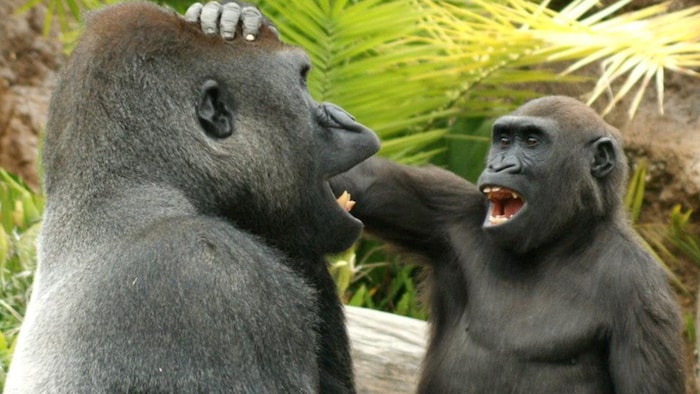Open in full screen mode Two gorillas play in the forest. Agence France-Presse The young of four species of great apes are, like very young humans, adept at teasing, according to a study which traces this character trait to a common ancestor several million years ago. Hand an object to the other, but remove it before they grab it. Do the opposite of what you are asked. Prevent the other person from grabbing something. So much common teasing among young children, from the age of eight months for the very youngest. On the tenuous border between play and aggression, teasing involves anticipating the reaction of the other to create a recreational moment, based on the effect of surprise, summarizes the #x27;study published in the journal Proceedings B (New window) of the British Royal Society (in English). What is interesting is that teasing rarely leads to aggressive behavior, its main author, Isabelle, explains to AFP Laumer, primatologist and cognitive biologist at the Max Planck Institute in Germany. The famous primatologist Jane Goodall had already noticed, while studying groups of free-ranging chimpanzees, that young ones sometimes disturbed older ones who were sleeping by jumping on them, biting them or pulling their hair, she recalls. And that their targets reacted rather calmly. Loading in progress ELSEWHERE ON INFO: Shots fired on the sidelines of the Chiefs parade With researchers from the anthropology department at the University of California at Los Angeles, Isabelle Laumer described the phenomenon in detail using 75 hours of video of the four species of great apes in captivity: chimpanzee, bonobo, gorilla and orangutan. Focusing on the activity of one juvenile of each species, aged three to five years, the team defined 18 types of teasing behavior. The most active is the chimpanzee, who loves to pat a dozing adult or get in their way. Just like the bonobo or the orangutan, the young chimpanzee happily takes advantage of an adult's full mop of hair to pull its hair. In the experiment, the gorilla stuck to classic provocations, including shoving. Most of this teasing is often the work of a young person, who immediately waits for a response from his victim before repeating his gesture until he obtains a reaction from it. In at least one event in five, teasing plays on the effect of surprise. And it almost always takes place in calm moments. The researchers also observed that, in a quarter of the situations, these episodes could lead to a real game, with a reversal of roles. This is proof that teasing remains a behavior distinct from play, which is necessarily reciprocal. It has an asymmetrical character, with usually a young person provoking an adult, while the play involves partners of similar size. The team also concluded that there were few differences in the type of teasing of the four species, with the downside of a still small number of observations, which nevertheless have an implication in the nature of teasing. evolutionary history. They suggest that teasing and the cognitive abilities it requires may have been present in the last ancestor common to all current primates, apes or humans. This ancestor dates back at least 13 million years. What purpose would teasing serve? Isabelle Laumer does not want to make any assumptions, but notes that in children it allows social boundaries to be tested and brings mutual joy which helps to strengthen a relationship. The researcher does not exclude that such behavior could exist in primates other than great apes, or even in large mammals.
Shots fired on the sidelines of the Chiefs parade
Young great apes can be teasing

